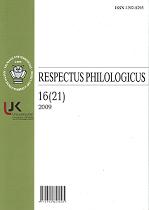DLKŽ* TARMYBĖS STATISTIKOS POŽIŪRIU
THE STATISTICAL APPROACH TO VERNACULARISMS IN THE DICTIONARY OF MODERN LITHUANIAN LANGUAGE
Author(s): Laima KalėdienėSubject(s): Language and Literature Studies
Published by: Vilniaus Universiteto Leidykla
Keywords: tarmybės1; bendrinė kalba2; žodynas3; statistiniai duomenys4; tarminis žodynas5;
Summary/Abstract: Since the new Dictionary of Lithuanian Standard Language is approaching completion, it is felt necessary to overview and evaluate the strengths and weaknesses of its precursor. This article focuses on the peculiarities of dialectal lexis selection and presentation; also, it introduces some statistical data. The third edition of The Dictionary of Modern Lithuanian Language comprises 2152 (2,9%) entry words with the mark indicating that they are vernacularisms. There are 698 (32,4 %) words with the general mark “tarm.” (vernacular), 8 (0,4 %) words with the partly generalizing mark “aukšt.” (Higher Lithuania), whereas the rest words are presented with detailed marks such as “dz.” (South Higher Lithuania), 487 (22,6 %) words with the mark of “ryt.” (East Higher Lithuania), 111 (5,2 %) words with the mark of “vak.” (West Higher Lithuania), 687 (31,9 %) words with the mark of “žem.” (Samogitians). If we analyze the words quantitatively, it is obvious that three percent of dialectal words of all the words in the dictionary are not a significant number; however, it is difficult to answer whether the statistical expression shows that the presented vernacular words are the most needed ones. Another question concerns the issue of equal representation of the dialects. The answer is directly related to the palette of dialectological marks since six dialectological marks are not of equal value, i.e. the general mark “aukšt.” (Higher Lithuania) should be rejected (only 0,4 % of all dialectal words were marked like this), the marks “dz.” (South Higher Lithuania) and “vak.” (West Higher Lithuania) do not correspond to the classification of the dialects. The words marked “tarm.” (vernacular) do not always appear to be in all dialects, thus, this mark should be rejected as misleading or it should be used in a generalized way for all dialects.The article maintains that the new DLKŽ (The Dictionary of Modern Lithuanian Language) should not contain some dialectal words since they have become old-fashioned and they do not belong to modern standard Lithuanian language. The analysis of DLKŽ shows that the number of vernacular marks would change if the word marking was unified under such marks as etnogr. (ethnography), kul. (cookery) or some other marks, for instance, from the sphere of agriculture, history or technology.It would be recommended to prepare such a dictionary of Lithuanian dialects alongside with the existing ones, and this dictionary could be of use for schoolchildren, students and all people who are interested in dialects. Furthermore, it should contain detailed illustrations and comprehensive explanations in modern standard Lithuanian.
Journal: Respectus Philologicus
- Issue Year: 2009
- Issue No: 16 (21)
- Page Range: 159-168
- Page Count: 10
- Language: Lithuanian

